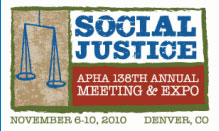In this Section |

230159 Girls 4 HOPE: Building community capacity to prevent HIV infection among Latina teen girlsMonday, November 8, 2010
Issues: Latinas represent 21% of AIDS cases diagnosed among all Latinos. Adolescent Latinas are more likely to experience health inequities due to socioeconomic disparities and lack of access to healthcare than white adolescent females. The community-based organizations (CBOs) that serve Latino populations experience challenges that include limited organizational resources, over-extended staff, and communities under economic stress. To mitigate the impact of HIV among Latino communities, and particularly young Latinas, these CBOs need additional support and training. Description: The Girls 4 HOPE program, through funding by the Centers for Disease Control and Prevention's Division of Adolescent and School Health, provides long-term capacity building assistance (CBA) to CBO program staff in order to improve the effectiveness and sustainability of culturally appropriate, evidence-based HIV prevention programs reaching African-American and Latina adolescent girls and their families. The program has provided CBA to 19 organizations across the United States. Lessons Learned: According to four years of aggregated data, CBOs that serve adolescents at high risk for HIV demonstrate a need for CBA related to program planning/implementation and understanding youth. With customized assistance, such CBOs can maximize existing resources and have a greater impact on the health outcomes of Latina adolescents. Recommendations: Providing CBA to organizations serving Latino populations at high risk of HIV infection is encouraged in order to strengthen prevention programs. Effective CBA recognizes and addresses the linkages between social injustices and HIV rates in the Latino communities, includes long-term follow-up support, and addresses the unique assets and challenges of each CBO.
Learning Areas:
Diversity and cultureImplementation of health education strategies, interventions and programs Planning of health education strategies, interventions, and programs Program planning Public health or related education Learning Objectives: Keywords: HIV/AIDS, Adolescent Health
Presenting author's disclosure statement:
Qualified on the content I am responsible for because: I manage a CDC-funded program that provides capacity building assistance to CBOs targeting African American and Latina teen girls. I agree to comply with the American Public Health Association Conflict of Interest and Commercial Support Guidelines, and to disclose to the participants any off-label or experimental uses of a commercial product or service discussed in my presentation.
Back to: 3369.0: Prevention of HIV/AIDS and STIs in Latino communities
|

 Click to
Click to